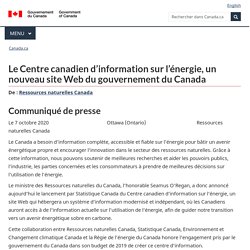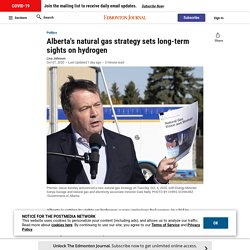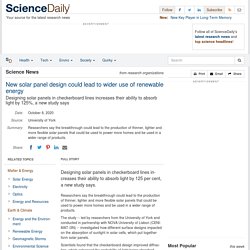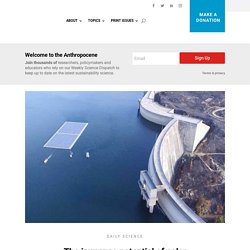

Le Centre canadien d’information sur l’énergie, un nouveau site Web du gouvernement du Canada. Le 7 octobre 2020 Ottawa (Ontario) Ressources naturelles Canada Le Canada a besoin d’information complète, accessible et fiable sur l’énergie pour bâtir un avenir énergétique propre et encourager l’innovation dans le secteur des ressources naturelles.

En chiffres - Canadian Renewable Energy Association. Canada has only begun to scratch the surface of its vast and untapped wind and solar energy resources, but it is already one of the world’s largest producers of wind and solar energy.

Our 13,413 MW of installed wind energy capacity ranked 9th in the world at the end of 2019. At that time, we also had approximately 3,000 MW of installed solar energy capacity. Home - UTC Power Grid. Alberta's natural gas strategy sets long-term sights on hydrogen. Kenney said the incentive program could be “in the range of a billion-dollar program,” but would involve offsets on future taxes.

The province also wants to add more processing and transportation infrastructure and to get more liquid natural gas to international buyers, with a goal of accessing Asian and European markets through two to three additional large-scale LNG projects by 2030. Natural gas production supplies liquids and diluents, or fluids, to many oilsands projects, and the government is betting that oilsands production and natural gas consumption will increase despite oil and gas supermajor BP declaring an end to the oil-growth era last month in a report that said consumption may never return to pre-pandemic levels.
The government did not outline the specifics or costs of the strategy’s initiatives, but Kenney said many will be funded by the Technology Innovation and Emissions Reduction levy, which is paid for by the province’s largest greenhouse gas emitters. New solar panel design could lead to wider use of renewable energy: Designing solar panels in checkerboard lines increases their ability to absorb light by 125%, a new study says. Designing solar panels in checkerboard lines increases their ability to absorb light by 125 per cent, a new study says.

Researchers say the breakthrough could lead to the production of thinner, lighter and more flexible solar panels that could be used to power more homes and be used in a wider range of products. The study -- led by researchers from the University of York and conducted in partnership with NOVA University of Lisbon (CENIMAT-i3N) -- investigated how different surface designs impacted on the absorption of sunlight in solar cells, which put together form solar panels. Scientists found that the checkerboard design improved diffraction, which enhanced the probability of light being absorbed which is then used to create electricity. The renewable energy sector is constantly looking for new ways to boost the light absorption of solar cells in lightweight materials that can be used in products from roof tiles to boat sails and camping equipment.
Float solar panels on reservoirs behind dams for more energy. Solar farms need vast swaths of land that might not always be easily available.

So why not put them on water? Many countries in Asia are starting to do that by sprinkling floating solar panels on lakes, ponds, and reservoirs. But coupling floating photovoltaics (PV) with hydropower could be even better, researchers show in a new study published in the journal Renewable Energy. Le parc éolien est très profitable - Beauce Média. FRAMPTON.

En décembre prochain, le parc éolien de Frampton aura 5 ans. The Outlook for the World’s Largest Biofuels Market. The U.S. is the world’s largest biofuels market.

Bolstered by more than a decade of supportive policy, almost one in every ten barrels of road fuel consumed in the U.S. is biofuel. Yet the growth potential of conventional biofuels is limited, and there is a growing need for biofuel producers and policymakers alike to adapt to changing demand dynamics. Biofuels can contribute to the decarbonization pathway for hard-to-abate sectors such as aviation. BloombergNEF’s ‘U.S. Biofuels Outlook’ analyzes the key themes shaping the outlook for biofuels for road use and otherwise. Currently, almost all biofuels are consumed on roads. This creates a serious challenge for biofuels.
This is particularly the case for ethanol. The outlook for biofuels in the diesel pool is more optimistic. French Ski Stations Turn to Hydrogen to Meet Zero-Carbon Target. Source: Kaessbohrer Gelaendefahrzeug AG France’s 250 ski resorts will switch to hydrogen-powered snow-grooming machinery as they seek to make good on a pledge to cut direct CO2 emissions to zero by 2037.

Diesel-fueled slope-preparation machinery produces 94% of the carbon emitted by French ski stations, with the running of lifts and snow-making equipment accounting for the rest, Alexandre Maulin, the head of industry group Domaines Skiables de France, said at a press conference on Friday. Que faire des 32 TWh de surplus d'électricité d'Hydro-Québec? Hydro-Québec a trois possibilités pour écouler ses surplus: exporter dans les autres provinces et aux États-Unis, électrifier l'économie québécoise, et développer de nouveaux marchés au Québec.

(Photo: Roméo Mocafico) Le Québec doit amorcer une réflexion en profondeur sur la manière de disposer le plus efficacement possible des surplus d’énergie d’Hydro-Québec (les volumes d’électricité annuelle disponible) qui sont actuellement estimés à environ 32 térawattheures (TWh). Voilà la principale conclusion d’une étude qui sera lancée officiellement le 13 octobre par la Chaire en gestion du secteur de l’énergie à HEC Montréal («Les surplus électriques en 2020»), qui a été réalisée par Christophe Bouchet, consultant en stratégies énergétiques, et Pierre-Olivier Pineau, titulaire de la Chaire et spécialiste en énergie. (Source tableau: HEC Montréal)